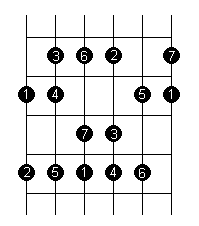
If you're used to playing more contemporary music (e.g. rock or blues) then you might well have been playing for years without really coming into direct contact with the major scale. So why should it concern you?
The main reason is that there's so much of music theory which is based upon the way things are in the major scale. Any other scale that you play (such as the natural minor, pentatonic or blues scales) is described with a formula that specifies how the notes in that scale differ from the notes of the major scale.
Its also a useful scale to know and be able to play from the point of view that it expands your musical vocabulary. If you're a dyed-in-the-wool metal-head then you might find that the major scale sounds a bit too 'happy' for your taste, but do learn about it because:
Trust me...I know what I'm doing.
So, with that in mind, have a look at this:
This shape can be moved around the guitar neck to allow you to play different major scales. For example, if you started with your middle finger at the 8th fret on the bottom E string, you'd be playing C major. That's why I've shown it here with numbers rather than note names.
The major scale is built from a starting (or 'root') note with a certain set of intervals. The formula for the intervals of the major scale is w-w-s-w-w-w-s, where 's' means a semitone and 'w' means a whole tone (2 semitones). For example, the C major scale is built like this:
Here the '8' note is referring to the root (1) note played one octave higher. If this scale was beingplayed ober 2 octaves, it would behave like the 1 note of the scale in the second octave, and would be followed by a D (the 2 note of the scale in the higher octave):
When you view the major scale in terms of the intervals within it, it becomes a very 'portable' thing. If you take any note and build upon it using these intervals, then you arrive at a major scale with that first note as its root. For example, starting on A and moving up through the intervals w,w,s,w,w,w, gives you A, B, C#, D, E, F# and G# - the notes of the A major scale. Try playing this on the guitar by using the shape shown above with your middle finger playing an A note at the fifth fret.
Believe it or not, this is the most important scale that you'll learn. Even if you hardly ever play it, the major scale is the foundation upon which all the other scales that you'll ever play are based upon. Once you are familiar with the major scale, you're ready to learn the scale's harmony (i.e. the chords that are found within it). And once you've learned the harmony of the major scale, you're in a very strong position to go on and apply these principles to other scales, such as the natural minor.
How useful did you find this tutorial?